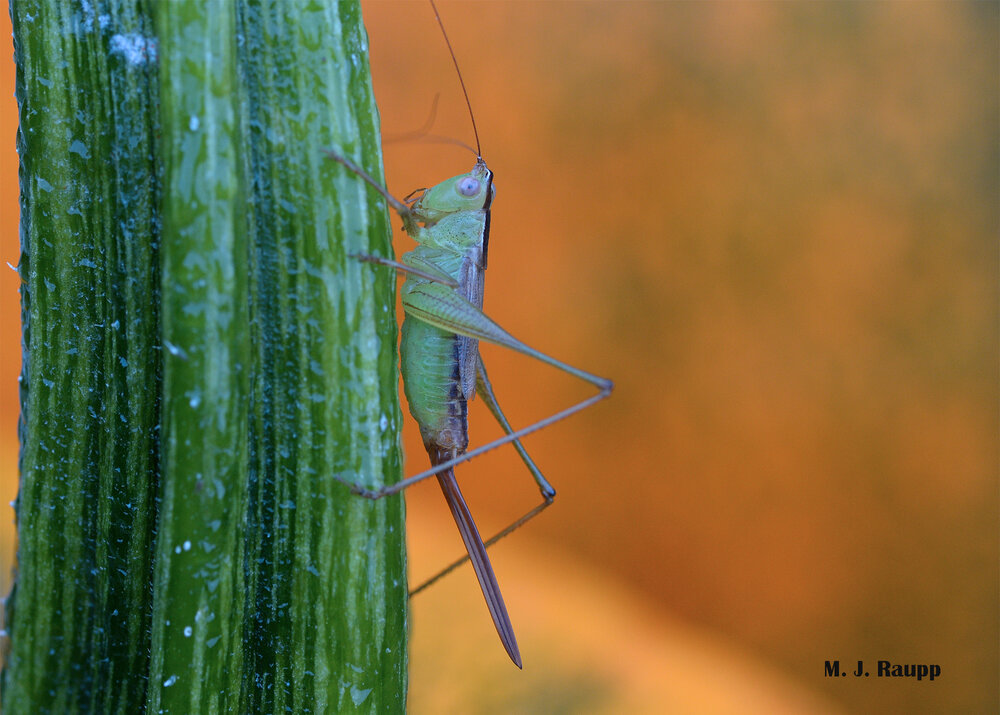Minstrels of the meadow: Short-winged meadow katydid, Conocephalus brevipennis

Female katydids are easily distinguished from males by their egg-laying appendage, the ovipositor, on their rear end.
September and October are spectacular months to head for the meadow. Many insects and other arthropods that have spent the entire spring and summer months developing reach their magnificent fully-grown size in autumn. On a recent outing with a hearty band of graduate students from the University of Maryland, we encountered one of the most interesting minstrels of the meadow, the delightful short-winged katydid. Armed with a bug net on a stick, one plucky student captured a gorgeous female katydid. While extracting said beauty from the net, Ms. Katydid demonstrated her prodigious leaping ability with a vault exceeding her body length by at least a dozen times.
Check out the super long egg-laying appendage called an ovipositor on the katydid’s rear end, her ginormous legs for springing away from danger, and her very short wings giving her the common name of short-winged meadow katydid.
In addition to observing and handling these amazing leapers, one of the true pleasures of fall is the serenade provided by katydids and their relatives, crickets. Both day and night in September and October, trills, chirps, and clicks can be heard in forests, meadows, and home landscapes as katydids and crickets engage in dating games. Katydids produce sound by rubbing a structure found on one forewing, called a scraper, against another structure, called a file, on the opposing forewing. These sounds are called stridulations. Many insects and other animals stridulate as a form of defense or to communicate with other members of their species. The song of the melodious male short-winged meadow katydid consists of a series of buzzes and ticks interspersed with short pauses. His goal is to attract a mate. At a distance, female short-winged katydids are first drawn to the general din created by several males as they vie to create the perfect song. After locating other members of her species, the lady short-winged meadow katydid plays the role of Ariana Grande on The Voice and judges the worthiness of her potential mate by the quality of his song. Clever scientists have found that the buzz component of the male’s song may be the vibe that seals the deal and wins her katydidly attention. To hear the courting song of the male short-winged meadow katydid, please click on the following link.
http://songsofinsects.com/katydids/short-winged-meadow-katydid
Like katydids we met in previous episodes, short-winged katydids are omnivores. Foliage, flowers, and occasional meaty tidbits like aphids are on the menu. As we admired our captive katydid, a question arose as to how one knows the gender of katydid. For many members of the katydid and cricket clans, this task is pretty simple. As with all insects, female katydids are the ones that lay eggs. To shield eggs from the wicked winter, female katydids of different species deposit eggs in protected locations beneath the surface of the soil, in plant tissue, or under the bark of a tree. This task is accomplished with the help of an elongated egg-laying appendage called an ovipositor, located on the rear end of the katydid. Males lack an ovipositor so differentiation of female and male katydids is a straightforward task. On a warm autumn day take a moment to visit the meadow and listen for the katydid’s song. If you are lucky enough to spot one, check for the ovipositor and see if you have discovered the troubadour, a male singing his heart out, or the object of his desire, the lovely female short-winged katydid.
Acknowledgements
We thank the Entomology Graduate Student Organization of the University of Maryland, Montgomery County Master Naturalists, and the Audubon Naturalists Society at Woodend for providing the inspiration for this and a previous episode about short-winged katydids. The interesting article “Calling Communication in Meadow Katydids (Orthoptera, Tettigoniidae): Female Preferences for Species-specific Wingstroke Rates “ by Patrick A. Guerra and Glenn K. Morris, and “Songs of Insects, A Guide to the Voices of Crickets, Katydids & Cicadas” were used to prepare this episode.
This post appeared first on Bug of the Week